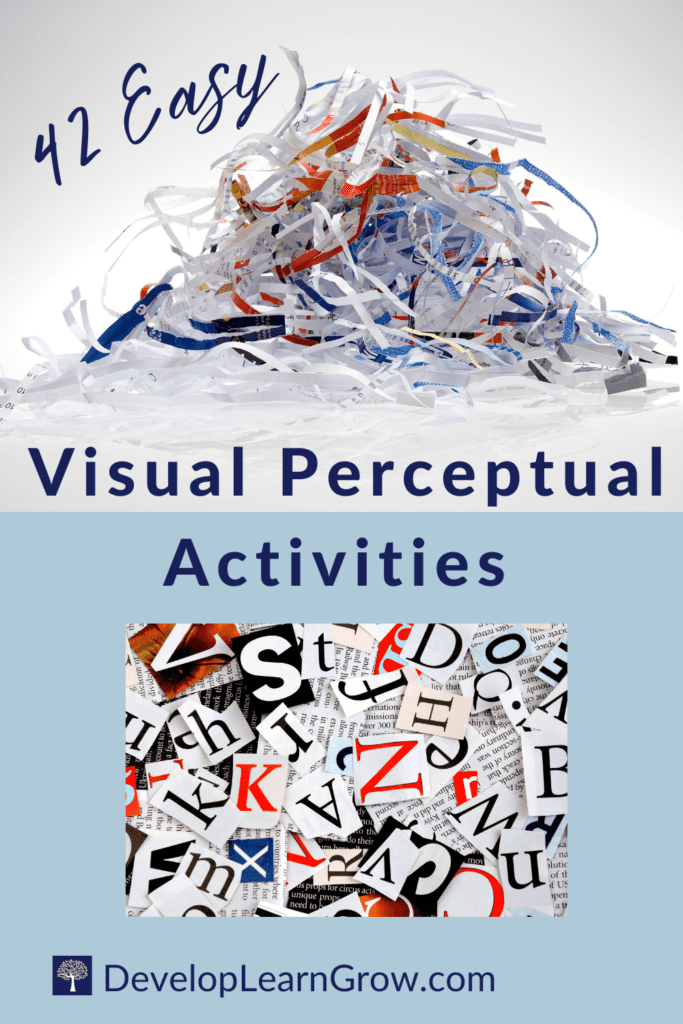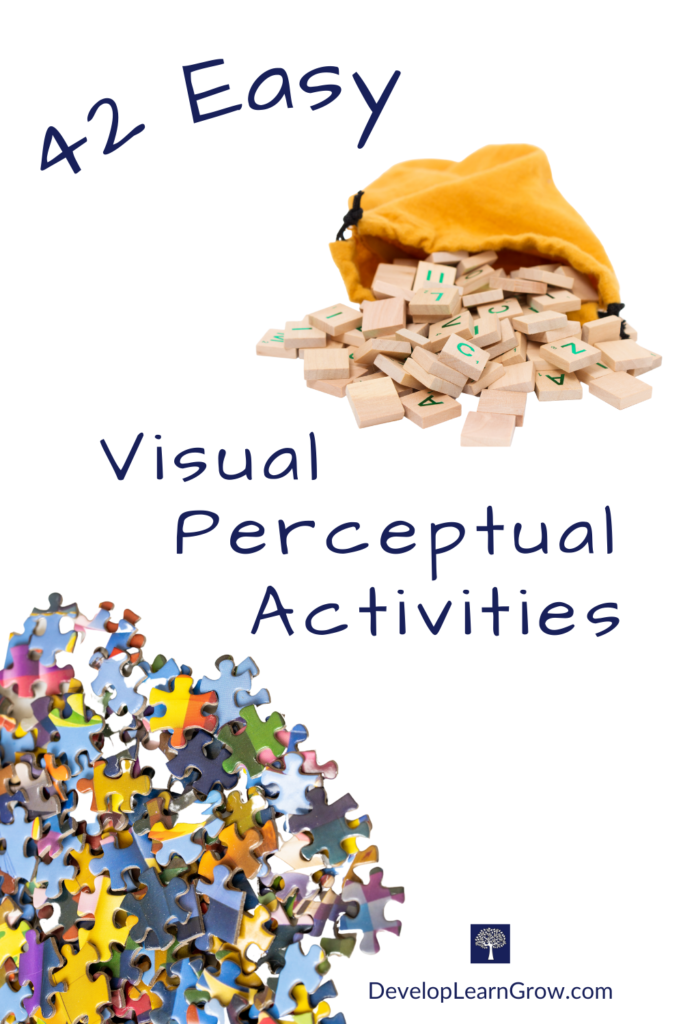Visual perceptual activities are great for a child’s developing brain! These 42 visual perceptual activities support the components of visual perception… part of the foundation for learning.
What is Visual Perception?
Visual perception is the brain’s ability to interpret what the eyes see.
Vision, just by itself, requires many skills and abilities:
- Focusing on objects up close
- Scanning the environment using the eye muscles
- Taking in info from all fields of vision
- Coordinating the eye muscles to work together
- Seeing and focusing on objects far away
- Adjusting to objects that are moving toward or away from the eyes
- Filtering light and adjusting to light
- Following moving objects with the eyes
- Focusing on objects while the body is moving
- Visually sustaining attention to objects and the environment
The eyes have such an important role… and so does the brain!
As the eyes constantly look, attend, and take in information, the brain has to make sense of what it sees.
The brain processes, perceives, and interprets what the eyes see. This is visual perception.
Visual perceptual skills rely on the brain’s cognitive abilities. A child has to remember and organize previous visual info. Then, it can automatically make sense of everything seen.
Many other systems play a role in supporting the visual system and visual perception.
Various postural muscle groups and the movement / balance (vestibular) system help support visual skills.
Sensory processing helps support the attention centers needed for the visual system. In order to effectively take in info, the eyes need to focus and attend well. But, at the same time, they have to ignore unnecessary visual info.
The brain’s job of actually making sense of what the eyes see (visual perception) is very complex! This post focuses on seven components of visual perception.
What Are the Components of Visual Perceptual Skills and How do They Impact Learning?
The seven components of visual perception are: visual discrimination, visual memory, spatial relationships, form constancy, sequential memory, visual figure-ground, and visual closure.
Each area is explained below. Additionally, visual perception examples are given for each area, showing how the components are part of learning.

Visual Discrimination
Visual discrimination is the ability to tell the difference between objects or the details of objects. It involves recognizing what’s the same and what’s different. This helps with matching and categorizing.
This skill is used when recognizing the difference between b-d, p-q, p-9, 5-s, etc. It’s used when kids recognize the difference between similar looking words.
Or, it’s used when telling the difference between leaves or shapes of states or countries.
Visual Memory
Visual memory is remembering an object and the characteristics of an object after it’s out of sight. Kids need to retain visual information for immediate recall, or for later retrieval.
This skill is used for learning shapes, letters, numbers, sight words, fact families, maps, patterns, etc.
It’s used when drawing a picture without a model. Or, when writing a descriptive story about an object or a picture.
Visual Spatial Relationships
Visual spatial relationships is the ability to recognize and understand the physical relationships between objects. It’s knowing the position of an object in space.
(The development of position in space is complete between ages 7 and 9. Spatial relationships improves up to age 10.)
This is an important skill in understanding directional concepts (left, right, between, under, down, etc)
Kids need this skill during prewriting and writing. It’s crucial when forming shapes, letters and numbers… especially ones with angles and curves.
Visual spatial skills are used when writing words and sentences with the correct letter size (tall, short, or hang below the line.) Additionally, the words have to be placed correctly on the writing lines.
Letter and word spacing is also necessary (proper space between words, but letters within a word are close together.) Understanding of margin sizes and space around the written work is also needed.
Kids also use spatial skills when organizing their math problems on paper (with or without lines.) They use it when figuring out maps, measurements, distance, patterns, and geometry.
Form Constancy
Form constancy is knowing that an object or form is the same no matter its size or what position it’s in. This helps kids understand consistency of objects.
(This skill improves between ages 6 and 7, and continues to develop until age 9.)
The brain can look at an upside down A, and still understand that it’s an A. Kids would also understand that an A is always an A, regardless of font or writing style (printed, italicized, bolded, upper/lowercase, etc.)
Children are able to form letters or words without reversing.
Additionally, form constancy involves looking at an object from a different angle but still knowing what the object is.
A picture of a world map on the wall is the same as a picture on paper in front of them. They understand that it’s the same, even though the wall map is much larger, and maybe even at a different angle.
Visual Sequential Memory
Visual sequential memory is remembering the correct order, series, or sequence of items.
This is extremely important for spelling, reading, and copying short text. It’s useful when remembering the sequence of a visual story. Or, when following written directions to complete a multiple-step task.
As kids get older, they have to remember longer words or a series of words when copying text from a book or from the board. It’s also used when remembering the correct order of equations and formulas.
Visual Figure-Ground
Visual figure-ground is the ability to visually locate an object in a busy background. It’s differentiating foreground from background.
This skill continues to develop in kids between ages 6 and 7.
It’s noticing an object, word, or letter with added visual input behind it. Such as on a busy worksheet.
Another example would be a child’s ability to locate a blue pencil on a blue marbled carpet. Or, to find a math equation, part of an animal’s life cycle, or the outline of a state in a pile of others.
Visual Closure
Visual closure is the ability to know what an object or picture is, when only presented with parts of it.
This would be recognizing part of a homework page when most of it is covered up by a notebook. It’s also knowing what a picture is, if only given parts of it (a partially completed puzzle… or a dot to dot picture that’s only partly finished.)
It’s seeing an outline of a leaf that has been erased in many areas. Even though all of the lines of the leaf are not complete, the brain can fill in the rest of the parts to identify it.
This is important when kids start to learn to read faster. They don’t have to look at every single letter of a word, or even at every single word.

Why Are Visual Perceptual Activities Important for Kids?
Visual perceptual activities support learning and cognition. They’re an important building block for the brain and for many academic subjects.
The visual perception skills and examples previously listed are essential parts of math, reading, spelling, writing, science and social studies!
They’re also important in staying organized and managing school materials.
If a child is having difficulty with any of the areas of visual perception, they can easily become frustrated. Frustration leads to a dislike of school, a low confidence level, potential behavior challenges, and even anxiety.
As a school based occupational therapist, I’ve worked with many, many kids who need support with visual perception.
I like using the Test of Visual Perceptual Skills (non-motor) to evaluate kids’ visual perception. This test assesses the 7 components that I’ve previously mentioned.
Checking all areas allows me to assess a child’s visual perceptual strengths and weaknesses.
Then, I’m able to offer very specific visual perceptual activities to the child’s educational team. The chosen activities address important skills to support the child’s learning.
42 Easy Visual Perceptual Activities for Kids
Examples of visual perceptual activities are listed below. They’re organized in each of the 7 areas previously mentioned.
I’ve only listed an activity once (under each category.) However, some activities and games address more areas than the one they’re listed under. (I chose the most relevant component area that the activity focuses on.)
If you want to start with the basics, there are simple ways to work on the foundation for visual perception during daily routines (visual tracking, visual attention, etc.) The following list gives specific examples of games and activities that support each component of visual perception:
Visual Discrimination Activities
- Matching complex shapes to outlines (Perfection)
- Dice games
- Sorting coins
- Dominoes
- “What’s Different?” Or “Find the Difference” Games
- Sort items by shape or size
Fun Visual Memory Activities
- Memory games
- What’s Missing? games
- Study the picture
- Word searches
- Line Up
- Concentration
Visual Spatial Relationships Activities
- Copy designs using pencils, pennies, small erasers, etc
- Geoboard patterns and designs
- Traffic Jam game
- How to Draw books
- Directionality games
- Proprioceptive activities (to improve body awareness)
Cool Visual Form Constancy Activities
- Spot It
- Jigsaw puzzles
- Tangrams
- Parquetry blocks
- Building sets
- Type spelling words using different fonts
Visual Sequential Memory Activities
- Scrabble
- Hangman
- Crossword puzzles
- Sequence game
- Copy patterns (make a pattern, cover it up and have child re-create)
- Stringing beads in a specific sequence or to spell non-sense words
Easy Visual Figure-Ground Activities
- I Spy
- Hidden Pictures
- Sensory Bins with Letters (to build words)
- Shredded paper with letters or words on other paper scraps (to build sentences)
- Crafts with small beads
- Jigsaw puzzles (also great for visual closure)
Visual Closure Activities
- Partly cover up complex shapes before matching to the outline
- Word shapes activities (match the word to the outline)
- Match pictures to incomplete pictures
- Scavenger hunts (partly hidden learning items)
- Dot-to-dots (identify picture before connecting dots)
- Erase parts of pictures or words for a guessing game

Hopefully this gives you a variety of activities to help your kiddos! Pin this on Pinterest so others can find it! Check out similar posts below.
For More Information on Visual Skills…
- How to Improve Reading with 15+ Visual Skills Activities – Support visual perception with these fun games and activities.
- Best Educational Toys and Games for Kids (Ages 5-10) – Several games and toys on this post support visual perceptual skill development.
- 17 Special Balance & Movement Activities to Improve Visual Skills – Use balance and movement activities to support and strengthen the visual system.



0 Comments